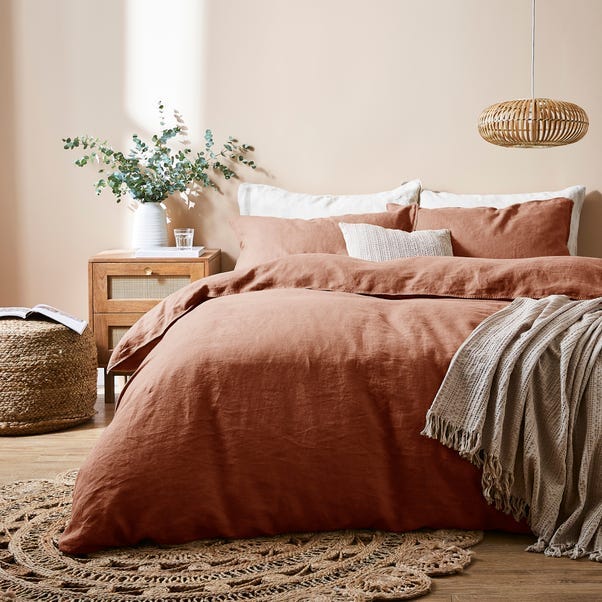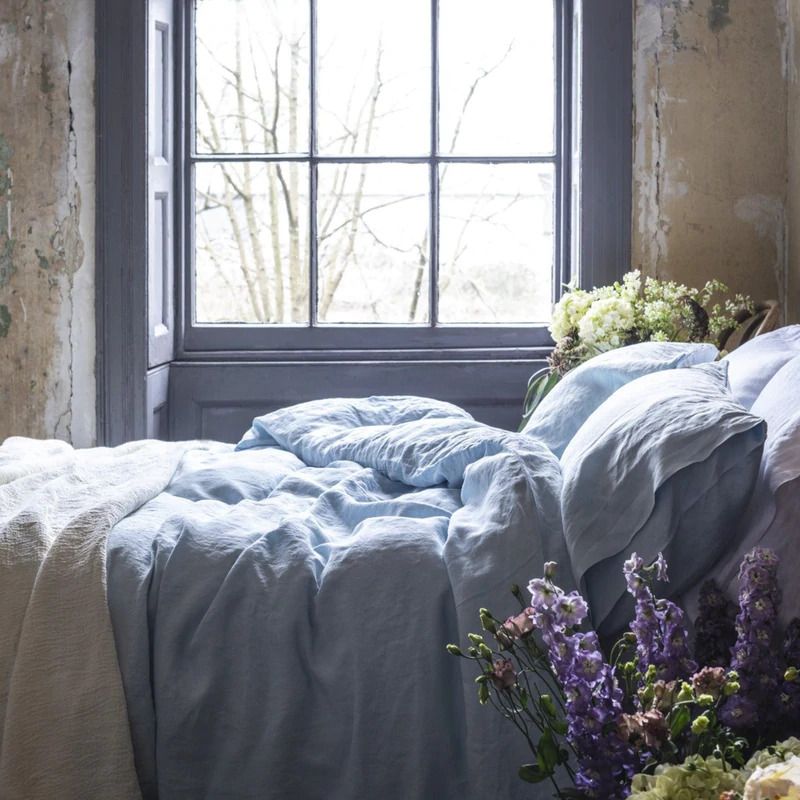Understanding Linen: The Eco-Friendly Alternative for Comfortable Living
When you think about environment-friendly fabrics, bed linen often stands out for its unique top qualities. What absolutely establishes bed linen apart from various other materials? Let's explore the remarkable globe of linen even more.
The Beginnings of Linen: From Flax to Fabric

Linen, one of the oldest fabrics understood to humankind, has an interesting journey that begins with the humble flax plant. Once collected, the flax stalks undertake a procedure called retting, where they're soaked to divide the fibers from the woody parts.
When you see bed linen material, you're experiencing centuries of workmanship. The weaving procedure transforms those spindles of thread right into the beautiful, resilient fabric you love. Bed linen has actually been valued for its natural look, making it a favored for whatever from garments to home textiles. Following time you touch linen, remember its rich background that links you to ancient societies and their traditional techniques.
The Special Properties of Bed Linen
Among the standout features of this impressive fabric is its breathability. When you put on bed linen, you'll see exactly how it allows air to circulate, keeping you cool on warm days. This building makes it a perfect option for summer season clothing and bed linens.
Linen also boasts outstanding moisture-wicking capabilities, drawing sweat far from your skin and permitting it to vaporize quickly. You won't really feel clammy, also in damp problems. In addition, bed linen is sturdy, usually becoming softer and more comfortable with each wash, which implies it can stand the test of time in your closet.
One more unique element is its all-natural structure; the small abnormalities offer bed linen a character that improves your design. Plus, it resists wrinkles much better than numerous various other fabrics, so you can appreciate a relaxed yet polished look without much effort. Accept linen, and you'll appreciate its comfort and unique beauty.
Environmental Benefits of Linen
When you select bed linen, you're not just going with a beautiful textile; you're also sustaining sustainable manufacturing techniques. Bed linen's eco-friendly and compostable nature makes it a wise selection for the setting. Plus, it needs considerably less water to generate contrasted to various other textiles, aiding preserve this precious source.
Sustainable Manufacturing Practices
Although numerous fabrics have considerable environmental influences, bed linen stands out due to its sustainable production practices. When you pick bed linen, you're deciding for a fabric made from the flax plant, which requires minimal water and chemicals.
Linen manufacturing is commonly less energy-intensive compared to other fabrics, as it includes natural procedures instead of artificial treatments. By supporting bed linen, you're adding to a more sustainable fabric industry that prioritizes green techniques. Choosing bed linen not just boosts your convenience but also straightens your worths with environmental obligation.
Compostable and biodegradable Product
Bed linen's green nature expands beyond its lasting manufacturing; it's compostable and additionally naturally degradable, making it an excellent choice for ecologically mindful customers. When you select linen items, you're deciding for products that damage down naturally, returning nutrients to the earth. Composting linen can enrich soil, advertising healthy plant growth.
Reduced Water Consumption
One of the standout benefits of linen is its reduced water intake during cultivation. Unlike cotton, which needs substantial irrigation, linen's flax plant flourishes on minimal water, making it a more sustainable choice. You'll appreciate understanding that for every load of linen generated, substantially much less water is needed contrasted to many other textiles.
Linen vs. Various Other Fabrics: A Contrast
When you contrast linen to various other fabrics, you'll see its remarkable breathability and convenience, making it best for cozy weather condition. And also, linen stands out for its sturdiness and longevity, commonly outlasting several typically utilized materials. As you consider your choices, the environmental influence of each fabric will likewise play a necessary role in your decision.
Breathability and Convenience
Breathability is an essential element in choosing fabrics for convenience, especially in cozy weather. Bed linen sticks out among materials for its exceptional ability to permit air circulation. Unlike artificial fabrics, which can trap warmth and dampness, linen's natural fibers wick away sweat, maintaining you completely dry and great. When you wear bed linen, you'll discover just how it feels light versus your skin, improving your comfort throughout hot days.
Cotton is often praised for its soft qualities, however it doesn't match bed linen's breathability. If you focus on comfort, specifically in summer season, bed linen should be your best choice.
Toughness and Long Life
While several textiles provide varying levels of resilience, linen really excels in durability, making it a wise investment for your closet. Unlike cotton or artificial products that may wear out swiftly, bed linen obtains more powerful with each wash. You'll find that bed linen's breathable nature additionally minimizes wear from sweat and dampness, which can damage other fabrics.
Environmental Influence Comparison
Although lots of textiles add to ecological problems, bed linen sticks out for click over here now its eco-friendly high qualities. Unlike cotton, which needs enormous water sources and pesticides, linen is made from flax, a plant that flourishes on marginal water and needs less chemicals. This implies you can really feel good concerning your choice while decreasing your carbon footprint.
When compared to artificial textiles like polyester, linen's biodegradability beams. While polyester can take centuries to break down, linen breaks down normally, returning nutrients to the soil.
Picking bed linen not just promotes lasting farming techniques however also supports a much healthier world. By opting for linen over standard fabrics, you're making an aware choice that benefits both your comfort and the setting.
Caring for Your Bed Linen Textiles
To ensure your linen fabrics continue to be in great problem, you'll want to adhere to some uncomplicated care standards. Wash your bed linen in cool water on a mild cycle to prevent it from reducing or losing its form.
When it comes to drying out, air drying out is ideal. If you make use of a dryer, pick a low warmth setting and eliminate the items while they're still a little damp to lessen wrinkles. Iron the linen while it's still damp for much easier handling, or heavy steam it to maintain it looking crisp.
For storage space, maintain your bed linen in a great, dry location. Avoid straight sunlight to avoid fading. With these easy techniques, your linen textiles will keep their charm and last for many years, making them a lasting addition to your way of life.
Including Linen Into Your Home Decoration
Taking care of your bed linen textiles not just protects their top quality but also opens a world of possibilities for integrating them into your home design. You can start little by including bed linen throw cushions to your couch, instantaneously raising the area with texture and warmth. Think about bed linen curtains that filter sunshine perfectly, creating a soft, airy environment in any space.
For a more rustic appearance, try utilizing linen table linens or joggers during dishes; they add a stylish touch and are simple to tidy. If you're feeling daring, mix and match various linen shades and patterns to produce a special, layered effect.
Don't forget bed linen blankets-- curtain one over a chair or your bed for an inviting feeling. By thoughtfully incorporating bed linen into your décor, you enhance both convenience and design, making your home a peaceful resort.
The Future of Bed Linen in Sustainable Living
As consumers progressively prioritize sustainability, linen becomes a frontrunner in green textiles. Its production uses much less water and chemicals contrasted to standard cotton, making it a much more ecologically liable selection. As you look in the direction of a lasting future, incorporating linen right into your wardrobe and home can considerably reduce your carbon footprint.
Innovative brand names are now focusing on sustainable techniques, from utilizing natural flax to implementing circular economic climate concepts. You'll locate that bed linen's durability implies it lasts much longer, reducing the need for constant replacements.
Moreover, as even more people embrace minimalist way of lives, bed linen's timeless appeal and convenience will maintain it appropriate. By choosing linen, you're not simply selecting convenience; you're additionally supporting lasting practices.
In the upcoming years, the demand for bed linen is anticipated to grow, solidifying its place in a more eco-conscious world. So, think about making linen a staple in your sustainable living trip.
Regularly Asked Inquiries
Is Bed Linen Ideal for People With Allergies?
Yes, bed linen's natural fibers are hypoallergenic, making it appropriate for people with allergic reactions. Its breathable nature helps reduce dampness and microorganisms accumulation, contributing to a healthier resting environment. You'll likely locate it comfy and secure.
Can Linen Be Colored Conveniently?
Yes, you can dye bed linen easily. Its natural fibers absorb dyes well, permitting for dynamic colors. Simply make certain you use the ideal dye type and adhere to proper strategies to attain the preferred outcomes without harming the textile.
Exactly How Does Bed Linen Contrast in Resilience to Cotton?

What Weight of Bed Linen Is Finest for Summertime Garments?
For summer season clothes, lightweight bed linen around 4 to 5 ounces per yard is perfect. It keeps you cool, breathable, and comfy in warm climate (Linen Australia). You'll appreciate how it drapes and moves with you can look here you effortlessly

Can Linen Be Utilized for Outdoor Furniture?
Yes, you can utilize bed linen for exterior furnishings. It's sturdy and breathable, making it a fantastic option for cozy climate. Just make sure to select a dealt with version to endure the elements and keep its look.
Final thought
Incorporating bed linen right into your life not just improves your convenience yet likewise supports a more sustainable future. With its distinct properties and marginal ecological influence, bed linen is a wise selection for your home decoration and way of life.
Linen's naturally degradable and compostable nature makes it a smart choice for the atmosphere. By integrating bed linen into your home, you're not just enjoying its comfort and durability; you're also supporting environmentally friendly practices and assisting create a healthier world. The Future of Linen in Sustainable Living.
